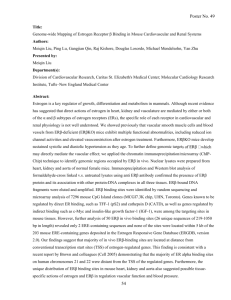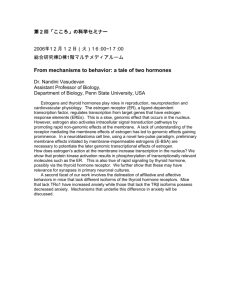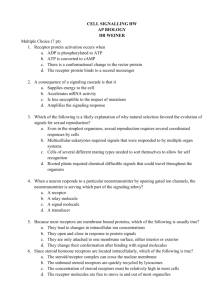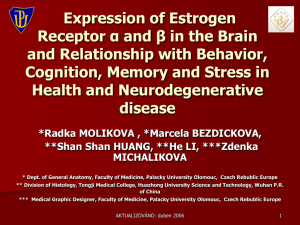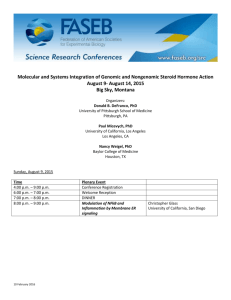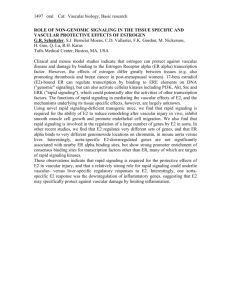Estrogen Receptor: New Paradigms in Localization, Function
advertisement
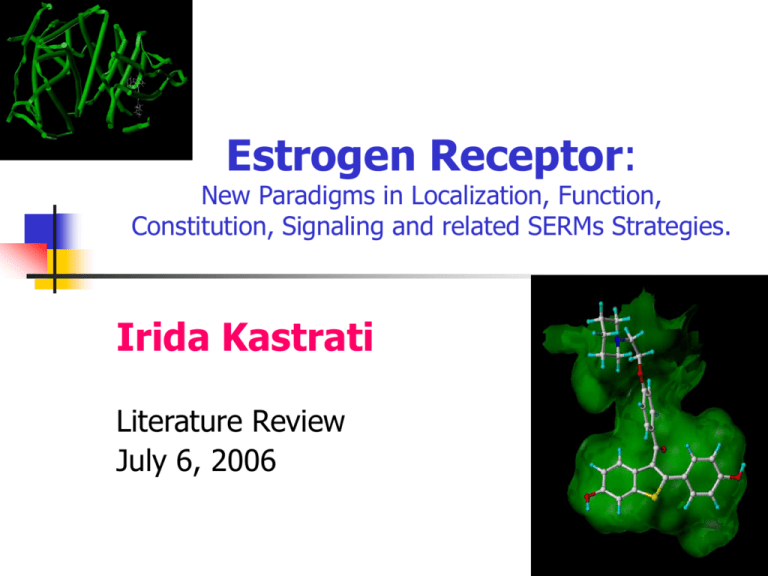
Estrogen Receptor: New Paradigms in Localization, Function, Constitution, Signaling and related SERMs Strategies. Irida Kastrati Literature Review July 6, 2006 Outline E2, ERs and Health Introduction of Estrogen Receptor Functional Domains – N/C-terminal domain – DNA-binding domain (DBD) – Ligand Binding Domain (LBD) Estrogen receptor-DNA interactions – Classical method with direct DNA binding – Regulation without direct DNA binding – Ligand independent genomic action – Non-genomic action Differential Ligand Activation of ERs ERs and Therapeutic Applications: SERMs Signaling Pathways Future Directions Why Estrogen Receptor? Estrogens are a class of sex steroid hormones that are synthesized from cholesterol and are secreted primarily by the ovaries, with contributions from placenta, adipose tissue, and adrenal glands. Estrogen (17β-estradiol, E2) is more than just the female hormone. It is essential and in both sexes and it has functions in: -the musculoskeletal system -central nervous system -hypothalamic pituitary axes -reproductive system -cardiovascular system -immune system Despite its beneficial effects in women’s health, E2 is implicated in development and progression of breast cancer. Breast Cancer Breast cancer was first recognized to be an estrogen-dependent disease in 1896, when the British physician George Beatson demonstrated that oophorectomy induced regression of mammary tumors in a subset of premenopausal patients. Breast cancer is the second leading cause of cancer deaths in women today and the most common cancer (excluding nonmelanoma skin cancers) among women in North America. On a global scale, it is estimated that breast cancer will affect five million women worldwide over the next decade. Above 75% of breast cancers are positive for ER and/or PgR, with E2 being the main stimulant. Endocrine therapy is the preferred first-line therapy in patients with nonaggressive, receptor-positive, metastatic breast cancer. Lewis, J. S.; Jordan, V. C. Selective estrogen receptor modulators (SERMs): Mechanisms of anticarcinogenesis and drug resistance. Mutat Res 2005, 591, 247-263. ERs: Steroid/Thyroid Hormones Receptor Superfamily ERs belong to the steroid/thyroid hormone superfamily of nuclear receptors. Receptors for steroids, retinoic acid, vitamin D3, and thyroid hormones and more than 60 nuclear receptors are identified. Characterized by central DNA-binding domain which targets receptors to HRE. Ligand binding domain is needed to switch receptor’s function. Unliganded SHRs associate with multiprotein complexes of chaperones. Beato, M.; Klug, J. Steroid hormone receptors: an update. Hum Reprod Update 2000, 6, 225-236. ERs: Steroid/Thyroid Hormones Receptor Superfamily ERα ERβ Lewis, J. S.; Jordan, V. C. Selective estrogen receptor modulators (SERMs): Mechanisms of anticarcinogenesis and drug resistance. Mutat Res 2005, 591, 247-263. Estrogen Receptor Two well-characterized isoforms of ER - ERα and ERβ and their alternatively spiced variants. A third isoform was proposed in 2000, designated ER-X in developing forebrain neurons. Plasma-membrane-bound ER (mER)? Contain three independent but interacting functional domains. -N-terminal or A/B domain (AF1) -DNA-binding or C domain, hinge D domain -C-terminal or E/F domain (LBD, AF2) The two main types identified ERα, ERβ are encoded by two distinct genes, and are similar in size (595 and 530 amino acids) and structure. Both receptors are considered to have similar affinity for E2 (KD for ERα was 0.05nM and for ERβ was 0.07nM) Estrogen Receptor-DNA Interactions Classical Mechanism E2-ER complex binds directly to EREs in target gene promoters. Non-Direct DNA Binding Mechanism—ERE independent Genomic Action Protein-protein interactions with other transcription factors. ER ER ERE TF ER Ligand-Independent Genomic Action P P Growth Factors activate Protein Kinase Cascades leading to ER ER phosphorylation (P) of ER at EREs. Non-Genomic Mechanism Membrane-associated ERs mediate estrogen actions. TF P X ER Functional Domains ERα is composed of 595 aa and is a 67kDa protein. ERβ, the long version, is composed of 530 aa and 59kDa. Koehler, K. F.; Helguero, L. A.; Haldosen, L. A.; Warner, M.; Gustafsson, J. A. Reflections on the discovery and significance of estrogen receptor beta. Endocr Rev 2005, 26, 465-478. Activation Function Domains: AF-1 and AF-2 A/B (AF-1) domain is a hormone-independent, constituitive activation function contributing to transcriptional activity of ER; AF-2 domain is hormonedependent. AF-1 is the least conserved between ERα and ERβ exhibiting only 30% identity. Both AF-1 and AF-2 are required for maximal ER transcriptional activity, but with certain promoters they can function independently. The activity of the ERβ AF-1 region is negligible compared with the AF-1 of ERα. Osborne, C. K.; Zhao, H.; Fuqua, S. A. Selective estrogen receptor modulators: structure, function, and clinical use. J Clin Oncol 2000, 18, 3172-3186. DNA binding Domain DNA binding domain (C domain) is the most highly conserved region with 96% identity. This allows both receptors to target similar sites. It is comprised of two Cys4 zinc fingers, with high homology to other members of the nuclear receptor superfamily. The Cys4 zinc fingers are redox sensitive. Reports suggest that 8/13 Cys residues located in two zinc-thiolate centers are essential for maintaining ER dimerization and DNA binding. The hinge region (D domain) is less conserved (30% identity). It contains the nuclear localization signal. Garban, H. J.; Marquez-Garban, D. C.; Pietras, R. J.; Ignarro, L. J. Rapid nitric oxide-mediated S-nitrosylation of estrogen receptor: regulation of estrogendependent gene transcription. Proc Natl Acad Sci U S A 2005, 102, 2632-2636. LBD: ERα vs ERβ C-terminal (E/F domain) encompasses the Ligand Binding Domain (LBD), a Coregulator binding surface, the Dimerization domain, a Nuclear Localization Signal, and Activation Function 2 (AF-2). Based on the crystal structure of the LBDs for ERα and ERβ, sequence alignment of their LBDs show 59% sequence identity. An analysis of the two receptors’ ligand binding pockets [each composed of 23 amino acids in direct vicinity (4Å) to E2] revealed two amino acid differences: ERα L384 -> ERβ M336 ERα M421 -> ERβ I373 Hillisch, A.; Peters, O.; Kosemund, D.; Muller, G.; Walter, A. et al. Dissecting physiological roles of estrogen receptor alpha and beta with potent selective ligands from structure-based design. Mol Endocrinol 2004, 18, 1599-1609. ERα vs ERβ Consequence: Although the volume of the sulfur-containing Met side chain (85.9 Å3) is slightly larger than the branched amino acid side chains of Leu and Ile (82.6 Å3 and 82.3 Å3), it is predicted that the increased flexibility of the linear Methionine side chain would allow larger substituents to be accommodated. Hillisch, A.; Peters, O.; Kosemund, D.; Muller, G.; Walter, A. et al. Dissecting physiological roles of estrogen receptor alpha and beta with potent selective ligands from structure-based design. Mol Endocrinol 2004, 18, 1599-1609. Distribution of ERα and ERβ Pearce, S. T.; Jordan, V. C. The biological role of estrogen receptors alpha and beta in cancer. Crit Rev Oncol Hematol 2004, 50, 3-22. Estrogen Receptor-DNA Interactions Classical Mechanism E2-ER complex binds directly to EREs in target gene promoters. Non-Direct DNA Binding Mechanism—ERE independent Genomic Action Protein-protein interactions with other transcription factors. ER ER ERE TF ER Ligand-Independent Genomic Action P P Growth Factors activate Protein Kinase Cascades leading to ER ER phosphorylation (P) of ER at EREs. Non-Genomic Mechanism Membrane-associated ERs mediate estrogen actions. TF P X I-Classical Mechanism: ERE dependent Gene Transactivation Mechanism Osborne, C. K.; Zhao, H.; Fuqua, S. A. Selective estrogen receptor modulators: structure, function, and clinical use. J Clin Oncol 2000, 18, 3172-3186. II-Non-Direct DNA Binding: ERE Independent Mechanism TF ER X ER can mediate transcription via tethered interactions through proteinprotein interactions at Activator Protein-1 (AP-1) and Specificity Protein-1 (Sp-1) sites. Genes can be activated by E2 through the interaction of ERs with Fos and Jun proteins at AP-1 binding sites (e.g. ovalbumin, IGF-I, collagenase, and cyclin D1). Transcription that depends on AP-1 is also repressed by ERs activated by E2 (e.g. choline acetyltransferase gene) Genes that contain GC-rich promoter sequences are regulated in a similar manner through the interaction of ERs with the Sp-1 transcription factor (e.g. LDL-R [low-density lipoprotein (LDL) receptor] , c-fos and cyclin D1 genes). II-Non-Direct DNA Binding: ERE Independent Mechanism TF ER X Besides AP-1 and SP-1 site, there are other indirect interactions of ER with DNA. Repression of the IL-6 gene by E2 is mediated through the interaction of ERs with two transcription factors, nuclear factor (NF-κB) and CCAAT/enhancer binding protein (C/EBP). ERs also regulate genes, such as the β–casein gene, that contain signal transducer and activator of transcription (STAT) 5 binding sites. Bjoernstroem, L.; Sjoeberg, M. Mechanisms of estrogen receptor signaling: convergence of genomic and nongenomic actions on target genes. Molecular Endocrinology 2005, 19, 833-842. III-Ligand-Independent Genomic Action P P ER ER ERα has been found to be phosphorylated at different sites by various ER phosphorylation at multiple sites is important because of the interaction between Growth Factor Signaling and ER. kinases, including the external signal-regulated kinase (ERK), cyclin ACDK2, c-SRC, protein kinase A (PKA), and pp90RSK1. Except for Tyr537 and Thr311 all known ERα phosphorylation sites are on Serine residues mostly located in the AF-1 region (Ser118 is the major one, S106, S104, S167, S236). Increased Growth Factor Signaling may account for the loss of E2 dependence, thereby producing antiestrogen resistant tumors (e.g. Tamoxifen resistance is related to enhanced cross-talk between the membrane ER and EGFR family member receptors, most notably ErbB2 (HER-2)). Pearce, S. T.; Jordan, V. C. The biological role of estrogen receptors alpha and beta in cancer. Crit Rev Oncol Hematol 2004, 50, 3-22. III-Ligand-Independent Genomic Action P P ER ER ER phosphorylation regulates interaction of ER activation domains and transcriptional coactivators. ER phosphorylation promotes receptor’s nuclear localization (MAPK pathway phosphorylation of ERα at Thr311). ER phosphorylation regulates receptor’s dimerization (Ser236 phosphorylation by PKA in DNA binding domain). IV-Nongenomic Actions of ER Mobilization of intracellular Calcium. Stimulation of Adenylate Cyclase Activity and cAMP production. MAPK Signaling. Phosphatidylinositol-3 kinase (PI3K)/Akt Signaling. *Are these signaling pathways mediated by a rapid acting membrane receptor? Integrated Genomic and Nongenomic ER Signaling Bjoernstroem, L.; Sjoeberg, M. Mechanisms of estrogen receptor signaling: convergence of genomic and nongenomic actions on target genes. Molecular Endocrinology 2005, 19, 833-842. Membrane-Associated ER Evidence favors the idea that the membrane localized receptor is the same protein as the nuclear receptor, transported to the plasma membrane by unclear mechanisms. About 5% of the ER protein in MCF-7 translocates to the membrane. Endogenous plasma membrane ERα exists in MCF-7 cells as mainly a homodimer in the presence but not in absence of E2 (KD=0.2nM). Certain motifs in the LBD of ER are critical to membrane localization and function. Their mutation will prevent dimerization and signaling through ERK, PI3K, and cAMP. Membrane ERs possibly exist as a cytoplasmic pool tethered to the inner face of the plasma membrane bilayer through binding to proteins such as caveolin-1, or through palmitoylation. Evinger, A. J., 3rd; Levin, E. R. Requirements for estrogen receptor alpha membrane localization and function. Steroids 2005, 70, 361-363. Endocrine Therapy and Chemoprevention Aromatase Inhibitors Selective Estrogen Receptor Modulators (SERMs) SERMs Unusual Tissue-Selective Pharmacology SERMs are ER ligands that in some tissue (i.e. bone, liver and cardiovascular system) act like estrogens, block estrogen function in others (brain and breast tissue) and mixed agonist/antagonist in the uterus. Numerous studies have examined the molecular mechanisms for the tissue selective action of SERMs, and collectively they indicate that different ER ligands induce distinct conformational changes in the receptor that influence its ability to interact with coregulatory proteins critical for the regulation of target gene transcription. SERMs: Chemical Structures Tamoxifen Tamoxifen was developed more than 30 years ago and was approved by the FDA in 1977 for the treatment of advanced breast cancer. Currently, it is approved for all stages of ER-positive breast cancer. In 1999, it became the first drug to be approved by FDA for breast cancer chemoprevention. Tamoxifen’s biological activity is attributed to the minor metabolite 4hydroxytamoxifen (4-OHT). Tamoxifen uterine toxicity is ER mediated; 4-OHT is estrogenic in the uterus inducing endometrium proliferation. Tamoxifen chemical toxicity involving oxidative metabolism leads to carcinogenicity. Raloxifene Raloxifene, originally developed for breast cancer in the late 1980s, was approved for the treatment and prevention of osteoporosis in postmenopausal women. Tamoxifen and Raloxifene share antagonist properties in breast and agonist properties in bone, but differ at the uterus in that tamoxifen acts as a partial agonist, while raloxifene is an antagonist. In addition to the benefits in bone health, a 75% reduction in the development of new breast cancer in women who did not have a prior history of breast cancer was observed. Raloxifene is as effective as Tamoxifen in breast cancer Chemoprevention (STAR trial). Raloxifene interactions in the ERα LBD Brzozowski, A. M.; Pike, A. C.; Dauter, Z.; Hubbard, R. E.; Bonn, T. et al. Molecular basis of agonism and antagonism in the oestrogen receptor. Nature 1997, 389, 753-758. Raloxifene vs E2 in the ERα LBD Brzozowski, A. M.; Pike, A. C.; Dauter, Z.; Hubbard, R. E.; Bonn, T. et al. Molecular basis of agonism and antagonism in the oestrogen receptor. Nature 1997, 389, 753-758. Helix 12 Position Conclusion: The resulting increase in exposed hydrophobic surface of ERα LBD correlates with a significant destabilization of ER in MCF-7 cells. Stability of ERα is decreased through an altered position of H12. Wu, Y. L.; Yang, X.; Ren, Z.; McDonnell, D. P.; Norris, J. D. et al. Structural basis for an unexpected mode of SERM-mediated ER antagonism. Mol Cell 2005, 18, 413-424. Helix 12 Position Pearce, S. T.; Jordan, V. C. The biological role of estrogen receptors alpha and beta in cancer. Crit Rev Oncol Hematol 2004, 50, 3-22. ER Plasticity: SERM Design The plasticity of the ER binding pocket has a number of important implications: 1.) Various ligands can induce different conformations of the internal binding cavity that may be transmitted to the exterior of the protein. These external changes in turn can result in differential binding of various cofactors resulting in altered pharmacology. 2.) The plasticity of the binding cavity complicates structure based design of ligands. As modifications of ligands are made to improve affinity or selectivity, unexpected changes in receptor conformation or ligand binding mode may occur. What dictates SERMs biological outcome? Unique pharmacokinetic properties that limit SERMs exposure to the different tissues. Unique conformation of the estrogen receptors induced by SERM binding. Recruitment of coactivators/corepressors. Availability of coactivators/corepressors in particular tissue. ER isoform ratio: ERβ expression relative to ERα, or other splice variants. Isoform Selectivity. Resistance to Metabolism, Reactivity, and Metabolic Clearance of the SERM. Stability (t1/2) of the SERM-ER complex. Ability to activate nongemonic signaling pathways. ER Signaling: Cardiovascular System NO E2 •Improved Vascular Health •Improved Lipid Profile •Reduced Cardiovascular Disease Vasodilation Platelet Aggregation Neutrophil Adhesion Mbai, F. N.; Hamilton, K. L.; Knowlton, A. A. Gender differences in cardiovascular disease: The effects of estrogen. Drug Discovery Today: Disease Mechanisms 2005, 2, 65-70. Mendelsohn, M. E.; Karas, R. H. The protective effects of estrogen on the cardiovascular system. N Engl J Med 1999, 340, 1801-1811. ER Signaling: Nervous System E2 is important in biochemical and genomic events required for the promotion of memory function and neuronal survival. Rapid E2 signaling cascades are associated with the neuroprotective and neurotrophic effects in hippocampal and cortical neurons. E2 signaling leads to a rapid rise in intracellular Ca2+. A niche of mER is the likely mediator. (At least 20ERα and 10ERβ splice variants). Zhao, L.; O'Neill, K.; Diaz Brinton, R. Selective estrogen receptor modulators (SERMs) for the brain: current status and remaining challenges for developing NeuroSERMs. Brain Res Brain Res Rev 2005, 49, 472-493. ER Signaling: Nervous System Schematic of estrogen-activated signaling cascades in hippocampal neurons. Zhao, L.; O'Neill, K.; Diaz Brinton, R. Selective estrogen receptor modulators (SERMs) for the brain: current status and remaining challenges for developing NeuroSERMs. Brain Res Brain Res Rev 2005, 49, 472-493. E2 Signaling in Hippocampus: Pitfalls The reliance of E2 on Ca2+ signaling to activate mechanisms required for morphological plasticity and neuronal survival is also its Achilles’ heel. Increasing calcium influx and calcium sequestration into cytoplasmic and mitochondrial compartments of neurons unable to maintain calcium homeostasis can only lead to exacerbation of calcium dependent degenerative insults. If neurons are healthy at the time of E2 exposure, their response is beneficial for both neuronal function and survival. In contrast, if the health status of the neuron is diseased or dysfunctional at the time of E2 exposure, the effect of E2 is deleterious. Zhao, L.; O'Neill, K.; Diaz Brinton, R. Selective estrogen receptor modulators (SERMs) for the brain: current status and remaining challenges for developing NeuroSERMs. Brain Res Brain Res Rev 2005, 49, 472-493. Proposed E2 Signaling in PC12 Cells Alexaki, V. I.; Charalampopoulos, I.; Kampa, M.; Nifli, A. P.; Hatzoglou, A. et al. Activation of membrane estrogen receptors induce pro-survival kinases. J Steroid Biochem Mol Biol 2006, 98, 97-110. NeuroSERMs To prevent age-associated neurodegenerative disorders by promotion of memory function and neuronal survival. To modulate climacteric symptoms such as hot flushes and sleep dysfunction in postmenopausal women. Selectively target and activate estrogen mechanisms of action in the brain while avoiding activation of ERs peripheral to the brain, particularly in reproductive organs. Thrombotic and neoplastic risks must be factored into the design of NeuroSERMs. Optimize timing, formulation and duration of the therapy intervention. Conclusion ER mediated transcriptional activity and signaling are complicated. The nonclassical mechanisms of ER mediated signal transduction and cross-talk are becoming increasingly more important. The ultimate goal of current research is to enhance the value of the separate estrogen receptors as targets for therapeutic intervention. Acknowledgements Gregory R. J. Thatcher Judy L. Bolton Pavel A. Petukhov Dr. Thatcher’s Lab Members Dr. Bolton’s Lab Members Thank You! Relative Binding Affinities (RBA) RBA for ERα of various ligands are: DES (468) > 4-OHT(178) > E2(100) > ICI 164,384(85) > Genistein(5) RBA for ERβ of various ligands are: 4-OHT(339) > DES(295) > ICI 164,384(166) > E2(100) > genistein (36) Aromatase Inhibitors In postmenopausal women, high plasma estrogen levels are now known to be associated with an increased risk of breast cancer. Aromatase is the enzyme that converts androgens (testosterone and androstenedione) to estrogens (estradiol and estrone). Aromatase activity in peripheral tissues and local malignant and normal breast tissue supplies breast cancer cells with the estrogen that stimulates cancer growth. Aromatase inhibitors act through pure estrogen deprivation to achieve an endocrine response in ER positive breast cancer. Aromatase is a microsomal cytochrome P450 in which the heme protein binds the androgenic substrate and catalyses a series of reactions that lead to the formation of the phenolic A-ring. Johnston, S. R. D.; Dowsett, M. Aromatase inhibitors for breast cancer: Lessons from the laboratory. Nature Reviews Cancer 2003, 3, 821-831. Aromatase Inhibitors Steroidal and Nonsteroidal Inhibitors. Used only in postmenopausal breast cancer patients. Accelerated bone breakdown and degradation of other E2-dependant systems. ERE Consensus Sequence AGGTCANNNTGACCT
